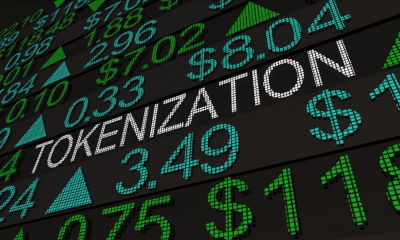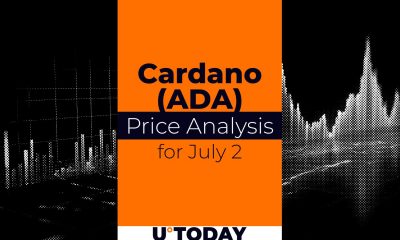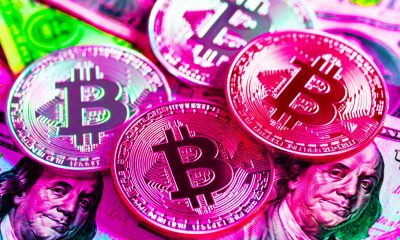

others
Australian Dollar consolidates after robust Monthly inflation, US Dollar remains firm – Crypto News
- The Australian Dollar appreciated after the higher-than-expected consumer inflation was released on Wednesday.
- Australia’s Monthly Consumer Price Index rose 3.6% YoY in April, surpassing the expected readings of 3.4% and 3.5% prior.
- The US Dollar rebounded due to higher US Treasury yields.
The Australian Dollar (AUD) pared its daily losses after the higher-than-expected Monthly Consumer Price Index was released on Wednesday. This strong data could prompt the Reserve Bank of Australia (RBA) to consider another rate hike. The minutes from the RBA’s May policy meeting suggested that the central bank had contemplated a potential interest rate increase.
The Australian Dollar struggled during earlier Asian hours due to increased risk aversion, evidenced by the stronger US Dollar (USD). This strength in the USD can be linked to rising US Treasury yields. The US Dollar Index (DXY), which measures the USD against six major currencies, was trading higher around, 104.70, with 2-year and 10-year US Treasury yields at 4.96% and 4.54%, respectively, at the time of reporting.
The US Dollar (USD) rebounded on Tuesday after Neel Kashkari, President of the Federal Reserve Bank of Minneapolis, suggested that a rate hike might still be possible. Kashkari stated, “I don’t think anybody has totally taken rate increases off the table,” and expressed uncertainty about the disinflationary process, predicting only two rate cuts.
According to the CME FedWatch Tool, the likelihood of the Federal Reserve implementing a 25 basis-point rate cut in September decreased to 41.7%, down from 44.9% the previous day. On Wednesday, New York Fed President John Williams is scheduled to speak, and the Fed’s Beige Book will be released, providing an overview of the current US economic situation based on interviews with key business contacts, economists, market experts, and other sources from the 12 Federal Reserve Districts.
Daily Digest Market Movers: Australian Dollar appreciates after higher consumer inflation
- International Monetary Fund (IMF) Deputy Managing Director Gita Gopinath, speaking from Beijing, announced an upgrade in China’s economic growth target to 5% from 4.6% for 2024, citing a robust first quarter. Gopinath also praised China’s initiatives to support its property market.
- Australia’s Monthly Consumer Price Index rose 3.6% year-over-year in April, surpassing the expected reading of 3.4% and the previous reading of 3.5%.
- US Housing Price Index (MoM) for March was underperforming, with March’s number coming in at 0.1% against 1.2% for February, where 0.5% was expected.
- Australia’s Retail Sales (MoM) rose by 0.1% in April, swinging from the previous 0.4% decline. This growth fell short of market expectations of 0.2%.
- On Tuesday, China’s Politburo, the country’s top leadership, announced that the government would enhance the coordination and integration of fiscal, monetary, investment, consumption, industrial, regional, and other policies with employment policies. Any economic changes in China could significantly impact the Australian market due to the close trade relationship between the two countries.
- At the 2024 BOJ-IMES Conference on Tuesday, Cleveland Federal Reserve President Loretta Mester emphasized the need for FOMC statements to provide a detailed description of the current economic assessment, its impact on the outlook, and the associated risks. Mester anticipates that the Fed will consider improving its communications as part of the next monetary policy framework review.
- Meanwhile, Federal Reserve (Fed) Governor Michelle Bowman stressed the importance of continuing to reduce the balance sheet size to achieve ample reserves as soon as possible, especially while the economy is strong. Bowman underlined the necessity of clearly communicating that any changes to the run-off rate do not indicate a shift in the Fed’s monetary policy stance.
Technical Analysis: Australian Dollar hovers around the key level of 0.6650
The Australian Dollar trades around 0.6650 on Wednesday. An analysis of the daily chart suggests a bullish bias for the AUD/USD pair, as it is positioned within a rising wedge. The 14-day Relative Strength Index (RSI) is slightly above the 50 level, further confirming this bullish bias.
The AUD/USD pair could potentially reach a four-month high of 0.6714, followed by the upper limit of the rising wedge around 0.6740.
On the downside, the 21-day Exponential Moving Average (EMA) at 0.6620 serves as key support, aligning with the lower boundary of the rising wedge. The next support level is at the psychological mark of 0.6600. A further decline could exert additional downward pressure on the AUD/USD pair, potentially driving it toward the throwback support region at 0.6470.
AUD/USD: Daily Chart
Australian Dollar price today
The table below shows the percentage change of the Australian Dollar (AUD) against listed major currencies today. The Australian Dollar was the strongest against the New Zealand Dollar.
| USD | EUR | GBP | CAD | AUD | JPY | NZD | CHF | |
| USD | 0.04% | 0.06% | 0.12% | 0.00% | 0.02% | 0.16% | 0.02% | |
| EUR | -0.06% | 0.02% | 0.08% | -0.05% | -0.03% | 0.12% | -0.02% | |
| GBP | -0.07% | -0.02% | 0.05% | -0.09% | -0.05% | 0.10% | -0.04% | |
| CAD | -0.12% | -0.09% | -0.05% | -0.14% | -0.09% | 0.05% | -0.10% | |
| AUD | 0.00% | 0.05% | 0.12% | 0.13% | 0.04% | 0.17% | 0.06% | |
| JPY | -0.02% | 0.03% | 0.05% | 0.09% | -0.03% | 0.15% | 0.00% | |
| NZD | -0.18% | -0.13% | -0.10% | -0.05% | -0.19% | -0.15% | -0.17% | |
| CHF | -0.04% | 0.03% | 0.05% | 0.10% | -0.04% | 0.00% | 0.15% |
The heat map shows percentage changes of major currencies against each other. The base currency is picked from the left column, while the quote currency is picked from the top row. For example, if you pick the Euro from the left column and move along the horizontal line to the Japanese Yen, the percentage change displayed in the box will represent EUR (base)/JPY (quote).
RBA FAQs
The Reserve Bank of Australia (RBA) sets interest rates and manages monetary policy for Australia. Decisions are made by a board of governors at 11 meetings a year and ad hoc emergency meetings as required. The RBA’s primary mandate is to maintain price stability, which means an inflation rate of 2-3%, but also “..to contribute to the stability of the currency, full employment, and the economic prosperity and welfare of the Australian people.” Its main tool for achieving this is by raising or lowering interest rates. Relatively high interest rates will strengthen the Australian Dollar (AUD) and vice versa. Other RBA tools include quantitative easing and tightening.
While inflation had always traditionally been thought of as a negative factor for currencies since it lowers the value of money in general, the opposite has actually been the case in modern times with the relaxation of cross-border capital controls. Moderately higher inflation now tends to lead central banks to put up their interest rates, which in turn has the effect of attracting more capital inflows from global investors seeking a lucrative place to keep their money. This increases demand for the local currency, which in the case of Australia is the Aussie Dollar.
Macroeconomic data gauges the health of an economy and can have an impact on the value of its currency. Investors prefer to invest their capital in economies that are safe and growing rather than precarious and shrinking. Greater capital inflows increase the aggregate demand and value of the domestic currency. Classic indicators, such as GDP, Manufacturing and Services PMIs, employment, and consumer sentiment surveys can influence AUD. A strong economy may encourage the Reserve Bank of Australia to put up interest rates, also supporting AUD.
Quantitative Easing (QE) is a tool used in extreme situations when lowering interest rates is not enough to restore the flow of credit in the economy. QE is the process by which the Reserve Bank of Australia (RBA) prints Australian Dollars (AUD) for the purpose of buying assets – usually government or corporate bonds – from financial institutions, thereby providing them with much-needed liquidity. QE usually results in a weaker AUD.
Quantitative tightening (QT) is the reverse of QE. It is undertaken after QE when an economic recovery is underway and inflation starts rising. Whilst in QE the Reserve Bank of Australia (RBA) purchases government and corporate bonds from financial institutions to provide them with liquidity, in QT the RBA stops buying more assets, and stops reinvesting the principal maturing on the bonds it already holds. It would be positive (or bullish) for the Australian Dollar.
-
others1 week ago
Japan CFTC JPY NC Net Positions increased to ¥132.3K from previous ¥130.9K – Crypto News
-

 Cryptocurrency1 week ago
Cryptocurrency1 week agoJio Financial Services Share Price Surges Above ₹325, But Faces Hurdle at ₹347 – Crypto News
-

 Blockchain6 days ago
Blockchain6 days agoWall Street Moves on-Chain Amid Tokenization of US Stocks – Crypto News
-

 Technology5 days ago
Technology5 days agoWho is Daniel Gross? Tech veteran who joins Meta as Zuckerberg deepens AI talent hunt – Crypto News
-

 Blockchain3 days ago
Blockchain3 days agoBitcoin Consolidation Continues: These Are Two Key Support Levels To Watch – Crypto News
-

 Technology1 week ago
Technology1 week agoTop 10 vacuum cleaners perfect for monsoon: Best picks for wet floors, muddy footprints and damp dust removal – Crypto News
-

 Cryptocurrency3 days ago
Cryptocurrency3 days agoTrent Share Price Crashes Over 9% After Weak Q1 Forecast, Nuvama Downgrade – Crypto News
-

 Blockchain3 days ago
Blockchain3 days agoBitcoin Consolidation Continues: These Are Two Key Support Levels To Watch – Crypto News
-

 others1 week ago
others1 week agoWTI price bearish at European opening – Crypto News
-

 Cryptocurrency1 week ago
Cryptocurrency1 week agoKatana mainnet launch nears as pre-deposit closes with $200M in active deposits – Crypto News
-
Business3 days ago
Is Roger Ver the Satoshi Era Bitcoin Whale Behind $8 Billion BTC Transfer? – Crypto News
-

 Blockchain3 days ago
Blockchain3 days agoBitcoin Consolidation Continues: These Are Two Key Support Levels To Watch – Crypto News
-

 Blockchain3 days ago
Blockchain3 days agoBitcoin Consolidation Continues: These Are Two Key Support Levels To Watch – Crypto News
-

 Blockchain3 days ago
Blockchain3 days agoBitcoin Consolidation Continues: These Are Two Key Support Levels To Watch – Crypto News
-

 Cryptocurrency1 week ago
Cryptocurrency1 week agoBitcoin rises above $107K as Trump’s fiscal policy comments boost hard assets – Crypto News
-

 Cryptocurrency1 week ago
Cryptocurrency1 week agoBitcoin rises above $107K as Trump’s fiscal policy comments boost hard assets – Crypto News
-

 De-fi1 week ago
De-fi1 week agoDeFi-focused Layer 2 Katana Launches Mainnet With $200 Million in Pre-Deposits – Crypto News
-
others1 week ago
US SEC May Slash Crypto ETF Listing Time to Just 75 Days – Crypto News
-
others1 week ago
Charles Hoskinson Says Cardano Needs Executive Voice To Lead Bitcoin DeFi Push – Crypto News
-

 others1 week ago
others1 week agoBest-Selling Author Ric Edelman Drastically Changes Crypto Investment Strategy – Here’s His New Stance: Report – Crypto News
-

 Technology1 week ago
Technology1 week agoVodafone Idea expands 5G services to 23 more cities, including Jaipur, Kolkata and Lucknow – Crypto News
-

 Technology1 week ago
Technology1 week agoZuckerberg Debuts Meta ‘Superintelligence’ Group, More Hires – Crypto News
-
Technology1 week ago
What Is a Solana Staking ETF and How Does It Work? – Crypto News
-

 Cryptocurrency1 week ago
Cryptocurrency1 week agoMichael Saylor’s Strategy acquires $531M in Bitcoin, boosting holdings near 600,000 BTC – Crypto News
-

 De-fi1 week ago
De-fi1 week agoBitcoin Firm BitMine’s Stock Surges Almost 700% on ETH Treasury Plan – Crypto News
-

 Technology1 week ago
Technology1 week agoTop 10 Lenovo laptops: Best all-rounders for work, gaming, browsing and entertainment – Crypto News
-

 Blockchain1 week ago
Blockchain1 week agoBitcoin Holders Near Pain Point Last Seen In October 2024 – Crypto News
-

 Technology1 week ago
Technology1 week agoElon Musk’s X adds AI to its Community Notes, promises faster fact-checks with a human touch – Crypto News
-

 Cryptocurrency1 week ago
Cryptocurrency1 week agoXRP price consolidates below $2.20 as whales halt sell-offs, breakout eyes $3.40 – Crypto News
-

 others1 week ago
others1 week agoBitcoin Increasingly Aligns With Store of Value Fundamentals – Crypto News
-
others1 week ago
Crypto Market Shaky as Elon Musk vs Donald Trump 2.0 Begins – Crypto News
-

 others1 week ago
others1 week agoWant to scrutinize how prices move after recent spike in price of rice moderates – Crypto News
-
Business1 week ago
XRP Mid-Year Recap 2025: Major Events Until June and Upcoming Developments – Crypto News
-

 Cryptocurrency1 week ago
Cryptocurrency1 week agoCardano (ADA) Price Prediction for July 2 – Crypto News
-

 Cryptocurrency1 week ago
Cryptocurrency1 week agoArbitrum jumps 5% on Robinhood news – But THIS can ruin ARB’s breakout – Crypto News
-
Business1 week ago
XRP Price As Grayscale Gets Greenlight for ETF Launch, Including XRP – Crypto News
-
Business6 days ago
Why Is Crypto Market Up Today? – Crypto News
-

 Cryptocurrency6 days ago
Cryptocurrency6 days agoNio Stock Price Forecast for 2025, 2027, and 2030: Buy the Dip? – Crypto News
-
Technology5 days ago
Turkey Bans Binance Chain DEX PancakeSwap Over Licensing Concerns – Crypto News
-

 Technology4 days ago
Technology4 days ago‘Notice the difference’: Elon Musk claims major upgrade to Grok chatbot’s question-answering abilities – Crypto News
-

 Cryptocurrency3 days ago
Cryptocurrency3 days agoBinance stacks Ethereum at yearly high, U.S. funds buy more: So why isn’t ETH moving? – Crypto News
-
Technology1 week ago
Bitcoin Exchange Balances Hit 6-Year Low, Sparks Supply Shock Expectations – Crypto News
-

 Cryptocurrency1 week ago
Cryptocurrency1 week agoBitcoin miners suffer at 12-year low – But why aren’t they selling? – Crypto News
-
Cryptocurrency1 week ago
XRP Lawsuit: Lawyer Clarifies Why Injunction Won’t Affect Ripple’s Institutional Sales – Crypto News
-

 Technology1 week ago
Technology1 week agoOpenAI reacts to Meta poaching top talent: ‘Someone has broken into our home…’ – Crypto News
-

 Cryptocurrency1 week ago
Cryptocurrency1 week agoSolana Skyrockets as Bitcoin and Ethereum Grind Higher: Where Do Prices Go Next? – Crypto News
-

 Cryptocurrency1 week ago
Cryptocurrency1 week agoBybit Partners With Backed to Bring Tokenised Stocks and ETF to Blockchain – Crypto News
-

 Blockchain1 week ago
Blockchain1 week agoTradFi Could Eye Blockchain Due To Banking Frustration – Crypto News
-

 Cryptocurrency1 week ago
Cryptocurrency1 week agoAptos price surges as stablecoin supply nears all-time – Crypto News
-

 Blockchain1 week ago
Blockchain1 week agoSEC to expedite crypto ETF listing process? – Crypto News












